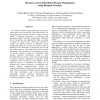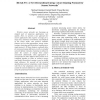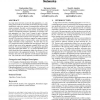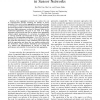IPSN
2004
Springer
14 years 12 months ago
2004
Springer
The efficacy of data aggregation in sensor networks is a function of the degree of spatial correlation in the sensed phenomenon. While several data aggregation (i.e., routing with...
SENSYS
2004
ACM
15 years 1 days ago
2004
ACM
Wireless sensor networks offer the potential to span and monitor large geographical areas inexpensively. Sensors, however, have significant power constraint (battery life), makin...
ICDCS
2005
IEEE
15 years 7 days ago
2005
IEEE
We consider distributed applications that continuously stream data across the network, where data needs to be aggregated and processed to produce a 'useful' stream of up...
HICSS
2005
IEEE
15 years 7 days ago
2005
IEEE
Wireless sensor networks are becoming an integral part of numerous applications very quickly. Here, we present a new approach for sensor applications that requires coverage for a ...
AICCSA
2005
IEEE
15 years 7 days ago
2005
IEEE
Recent years have witnessed a growing interest in the application of wireless sensor networks in unattended environments. Nodes in such applications are equipped with limited ener...
SENSYS
2006
ACM
15 years 17 days ago
2006
ACM
Computing and maintaining network structures for efficient data aggregation incurs high overhead for dynamic events where the set of nodes sensing an event changes with time. Mor...
SASN
2006
ACM
15 years 17 days ago
2006
ACM
In a large sensor network, in-network data aggregation, i.e., combining partial results at intermediate nodes during message routing, significantly reduces the amount of communic...
PEWASUN
2006
ACM
15 years 17 days ago
2006
ACM
We present an algorithm implementing the failure detector class omega (Ω) in the crash-recovery model to coordinate data aggregation in wireless sensor networks. In order to mini...
IPPS
2006
IEEE
15 years 19 days ago
2006
IEEE
Abstract— Since sensor nodes normally have limited resources in terms of energy, bandwidth and computation capability, efficiency is a key design goal in sensor network research...
INFOCOM
2006
IEEE
15 years 20 days ago
2006
IEEE
— Data aggregation protocols can reduce the cost of communication, thereby extending the lifetime of sensor networks. Prior work on data aggregation protocols has focused on tree...




